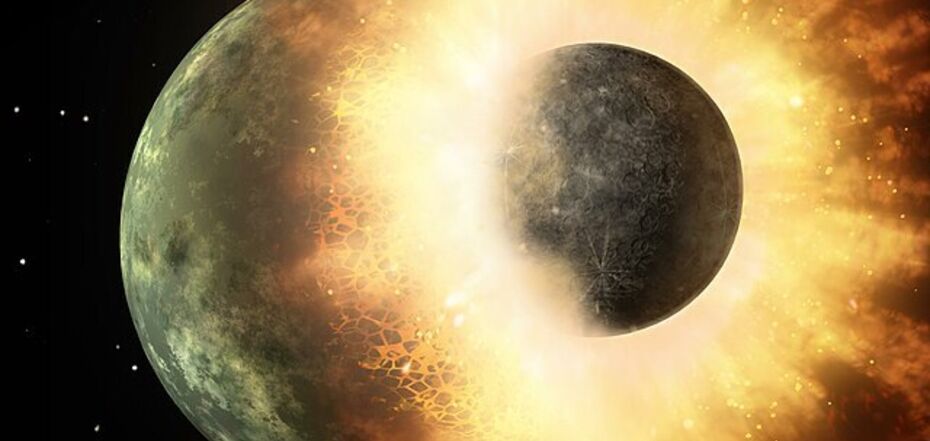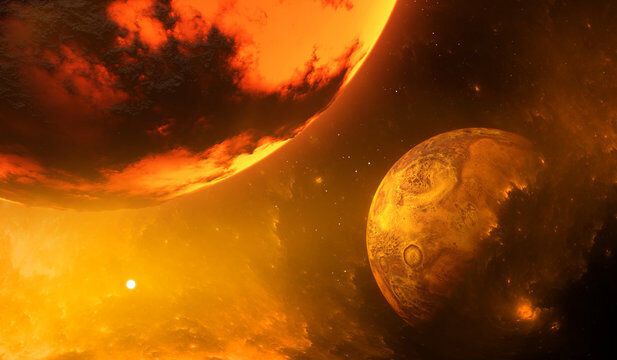News
Scientists have discovered the remains of a "buried planet" inside the Earth: Theia was the size of Mars
Evidence has been found for the existence of a planet that crashed into the Earth a long time ago. A new study of metal ore in the depths of the Moon supports the version that the Earth's satellite was formed as a result of this collision.
According to scientists, the catastrophe occurred about 4.5 billion years ago, Mail Online reports. A planet the size of Mars called Theia shattered into fragments of hot lava upon impact with the Earth.
Some of Theia's remains are buried as dense and massive "clumps" deep under the tectonic plates of Africa and the Pacific Ocean. But scientists say that there has been no evidence of where the rest of Theia went after this catastrophe.
New data obtained by NASA's Gravity Recovery and Interior Laboratory (GRAIL) spacecraft have revealed large deposits of titanium-iron ore deep beneath the Moon's surface. This may indicate that other remnants of Theia actually formed the Moon.
Planetary geophysicist Adrien Brocke of the German Aerospace Center in Berlin described NASA's GRAIL findings as nothing short of "fascinating."
His team's new paper, published this April in the journal Nature Geoscience, focuses on "gravitational anomalies" deep beneath the Moon's surface: dense, heavy pockets of matter detected by the GRAIL spacecraft's sensors.
"Analyzing these variations in the moon's gravitational field allowed us to look beneath the surface of the moon and see what lies beneath," Brockett said.
Under the lunar crust, between the mantle and the core, two dense areas were found that could be deposits of titanium and iron called ilmenite. They indicate the validity of the theory of a collision with Thea.
After the probable collision and burial of fragments of this lost planet deep under the Earth's crust, molten lava basins of heavy titanium and iron on the Moon's surface began to sink deeper into its core, pushing lighter rocks up. In other words, the Moon turned inside out.
The theory of an interplanetary collision has been confirmed by studies of the Earth's mantle. In particular, there are two similar dense areas known as Large Low Shear Velocity Plumes (LLSVP).
One is located under the African tectonic plate and the other under the Pacific tectonic plate. They were measured with seismic equipment similar to that used to detect earthquakes.
Their existence was established when geologists discovered that seismic waves slow down dramatically at a depth of 2900 km in these two regions, which are different from other parts of the Earth.
Scientists believe that the material in these LLSVPs is 2-3.5% denser than the mantle surrounding the Earth.
Last year, researchers led by the California Institute of Technology proposed that these LLSVPs could have formed from a small amount of Theia material that fell into the lower mantle of the ancient Earth.
To confirm this, they asked Professor Hongping Deng of the Shanghai Astronomical Observatory to investigate the idea using his innovative computational fluid dynamics techniques.
After running a series of simulations, Professor Deng found that after a moon-forming impact, a significant amount of Theia's material – about 2% of the Earth's mass – would have fallen into the lower mantle of the ancient planet Earth.
"Through precise analysis of rock samples, combined with more advanced giant collision models and Earth evolution models, we can infer the material composition and orbital dynamics of primordial Earth and Theia," said co-author Deng Qian Yuan, a geophysicist at the California Institute of Technology who also worked on the project.
Brockett said that he hopes that future NASA missions to the Moon, like those planned under the Artemis program, will be able to conduct similar seismic measurements: the first of its kind seismic data from the Moon that will better support the Theia collision theory.
Only verified information is available on the OBOZ.UA Telegram channel and Viber. Do not fall for fakes!





























